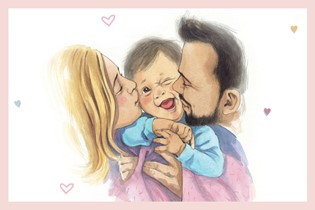How are obstetricians different from midwives

How are obstetricians different from midwives and how do the two professions work together? Dr Nick Walker explains the finer details.
I work as an obstetrician in a large busy hospital – this means I care for families having completely normal births, as well as those affected by medical and obstetrical complexities. The core role of an obstetrician is to advise how, when and where to have a baby – then to step in and physically assist if necessary.
Safety and woman-centeredness are the guiding principles behind everything we do. I work in the public service; teaching and supervising junior doctors, in addition to the actual work of helping with deliveries. I also work as an LMC (lead maternity carer), guiding people from the beginning of their pregnancy all the way through to labour and birth.
Qualifications & training
Obstetrics is a career which begins after six years of medical school and two years of general junior doctor work. It became my specialty of choice coincidentally at the time my wife and I were expecting our first baby, so my training and life experience really rolled into one. Due to the long and unpredictable working hours, only a handful of medical graduates each year go into training to be an obstetrician. For those who appreciate the rewards of assisting with the safe arrival of a baby, the hours spent and sleep missed are absolutely worth it.
However, it is so much more than delivering babies – during the daytime hours we educate and inform expecting couples; empowering them in anticipation of the big day. We monitor the progress of their babies and get to enjoy their milestones as they grow and develop in utero. We get to follow couples until around six weeks after the birth, when the baby is often beginning to smile. And if all goes well, we may be lucky enough to see them as toddlers when their mum returns for care with a sibling on the way!
Obstetricians VS midwives
The difference of practice between midwives and obstetricians is best explained by whether the pregnancy is uncomplicated or complicated. Midwives are experts in birth that is uncomplicated and are skilled in dealing with minor complications arising during pregnancy or labour. At the other end of the spectrum, obstetricians are experts at managing complications ranging from minor to major. Midwives outnumber obstetricians 20:1 in New Zealand (there are roughly 3000 midwives and 150 obstetricians), which is a handy ratio as around 95% of pregnancies and around 85% of births are uncomplicated. These two professions are neatly complementary and, I believe, provide a great balance in the maternity workforce.

Maternity care in New Zealand is government funded and access to an obstetrician for either prenatal advice or in-labour care is guaranteed by your DHB. Guidance on when you should seek an obstetrician’s opinion is based on the Ministry of Health's rules set under law.
In some areas of the country, you may have access to an obstetrician working in private practice – they will be able to manage the whole range of pregnancy and birth complications if required, though equally they will be happy to not assist if the birth is straightforward and uncomplicated. Private practice obstetricians are funded by the Ministry of Health (as are all LMCs) but will add on a surcharge for their expert supervision. It pays to call ahead and check their fee schedules if you are planning to book with one. Due to limitations on the case workload of an obstetrician, they often fill their bookings quickly so it is a good idea to call them as soon as you are pregnant.
Act 88 explained
In 2000, the New Zealand Public Health and Disability Act was signed. The stated aims of section 88 of this act were to improve maternity care safety and quality; improve the consistency of consultation, transfer and transport processes; give confidence to women, their families and whānau; and promote and support coordination of care across providers.
The act ‘goes live’ when you sign a form with your LMC during any stage from pregnancy confirmation through until six weeks postnatal. The continuity of having one LMC is the great strength of this method, and built into the act is the requirement for any LMC to have a back up(s), so that you always have someone to call for assistance and advice during this special time of your life.
A very important guiding principle of the act is that you, your baby and your family are at the centre of all processes and discussions. Other guiding principles protect your right to full and unbiased information on your options and their consequences, as well as the right to informed decisions in all aspects of your care and the right to decline options or referrals to other parts of the health service. For a fuller version of the details, the Ministry of Health website has the complete notice for you to read and further find out what you have signed up for (and what your LMC has signed up for!)
At a practical level, the act protects you as a pregnant woman by giving really clear instructions as to when you or your baby ought to be offered referrals for extra advice or hands-on management over and above what your LMC can provide. While we all hope to have a ‘normal’, uncomplicated pregnancy, sometimes nature has other plans and the act provides a long list of possible things that may happen, and how best to deal with each scenario.
Referrals
Appended to the act is a list of four referral categories: Primary, Consultation, Transfer and Emergency, ordered by increasing levels of seriousness. Following these four categories is a very long list of pregnancy complications indexed by referral category.
PRIMARY
REFERRAL
Primary referral category items mean that your LMC should suggest referral to your general practitioner, another midwife, or an allied health professional such as a physiotherapist, dietician or lactation consultant. Primary referral reasons are limited to low-level problems which have little impact on pregnancy, such as heart palpitations, gallstones, mild asthma and flu-like illnesses. Even conditions like well-controlled epilepsy and hypothyroidism fit into this category too. Postnatal examples would include post-partum depression and minor problems detected during a newborn clinical examination.
CONSULTATION
REFERRAL
Consultation referral category items mean your LMC must advise that your issue warrants discussion with a specialist relevant to the issue in question – this will most often be an obstetrician for yourself or a paediatrician for your baby. Other types of specialists could be surgeons, physicians, anaesthetists or psychiatrists. As a result of a consultation, the next category – transfer – may be recommended.
Consultation referrals indicate an elevated level of problems which are directly linked to pregnancy, or could significantly influence your pregnancy outcome indirectly. Consultation referrals are indicated by events noted during a previous pregnancy or birth which stand a higher chance of occurring again. Examples of these types of problems include having birthed by Caesarean section or other complicated birth experience, such as the baby’s shoulder getting stuck, major obstetric injuries or postnatal bleeding. Previous preterm birth is a risk factor for preterm birth, so it’s in this category also. Overly large or small babies in your past births count as referral reasons too.
Factors arising during the labour account for many consultation items, eg breech presentation, having your labour induced, the presence of meconium in the amniotic fluid, and being more than a week past your due date. Not surprisingly, twin birth definitely requires consultation, not only due to potential complexities but simply to provide more hands on deck! Medical reasons for consultation tend to be the more serious versions of those listed in the primary referral category, such as gestational diabetes, high blood pressure, hepatitis and kidney disease.
TRANSFER
REFERRAL
Transfer referral category items mean your LMC must advise that the clinical responsibility of your care be handed over to a specialist – note the important difference from a consultation referral whereby your LMC is still responsible for your care. The timing of transfer of responsibility back to your LMC and the management strategies for dealing with your issues are detailed according to the nature of the problem.
In both these categories, a key feature is the importance placed on three-way communication between you, your LMC and the relevant specialist. Transfer referrals ensure that the most extreme examples of medical and maternity related matters are managed appropriately, and include serious heart disease, pre-existing diabetes, blood clots in the legs or lungs, cancers and infections diseases with major impact on your baby, such as HIV, listeriosis and toxoplasmosis.
If your baby is very small or has drastically reduced amniotic fluid, your care will be best transferred. A common reason for transfer during labour is when a baby is firmly stuck and an obstetrician is required to assist delivery. Conditions such as acute or severe sepsis, or a rare complication of mental health (such as acute psychosis) would also require a transfer.
EMERGENCY
The final category is emergency. In these situations, the clinical decisions are escalated to the most appropriate caregivers on hand. These caregivers will vary according to circumstances, and as road or air transport may be required, rapid handovers and transfers are likely to occur.
These cases are often stressful for you and your caregivers, and the guiding process maps are helpful to keep everybody calm and ensure the best possible outcome. Fortunately, emergency cases occur very rarely. Cardiac arrest, pregnancy seizures (eclampsia), and umbilical cord prolapse (when the baby’s cord comes out of your body after the waters break) are examples where absolute speed of action is necessary.
Declining treatment
Reiterating the Health and Disability Code of Patient Rights, your right to informed consent and your right to decline treatment are cornerstone principles ensuring that you remain at the centre of all processes and decisions. When you decline treatment, your LMC has the option of continuing your care, or declining to continue in which case they must make efforts to connect you to another LMC. Clearly these can be awkward and frustrating situations on both sides and the guiding principles of section 88 are designed to keep safety at the forefront.
Together is better
The Section 88 guidelines do not specify exactly the role of your LMC, reflecting the fact that LMCs do not fit into any single job description. Most LMCs are midwives, some are obstetricians, some are doctors also working in general practice. Some midwives do not get actively involved in birthing your baby, instead focussing on postnatal care (and vice versa).
Generally, obstetricians like myself are not great at assisting you with breastfeeding advice, better to see a midwife or lactation consultant! The wonderful thing about the Section 88 act is the safety net it provides for you and your baby, a net comprised of interlinked health professionals working together with you, when and where required. It has served our maternity system well since its introduction over 20 years ago, recognising that all roles and responsibilities are valued during this important time for you and your baby.
Dr Nick Walker is a specialist obstetrician working in public practice at National Women's Hospital and private practice in Auckland. He divides his time between these roles and helping his wife care for their four children.

AS FEATURED IN ISSUE 54 OF OHbaby! MAGAZINE. CHECK OUT OTHER ARTICLES IN THIS ISSUE BELOW

















